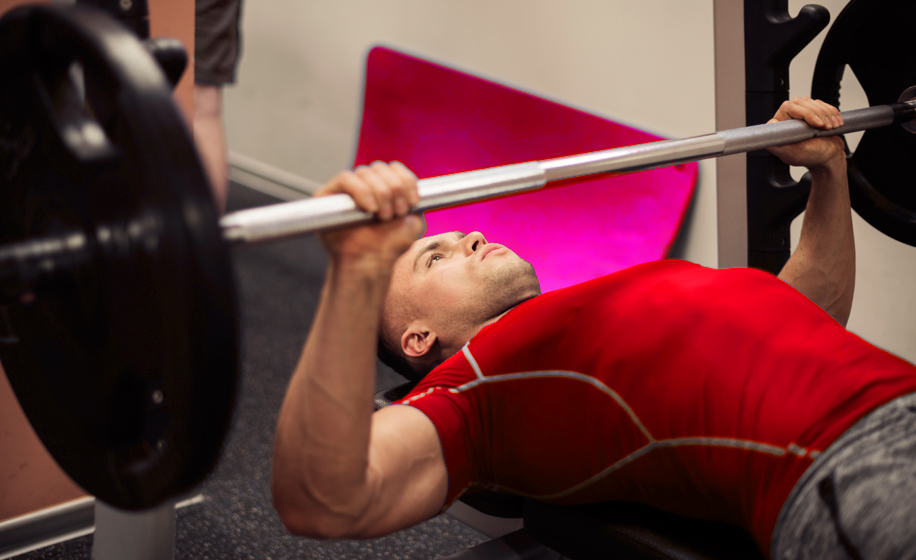Our Blog

How to Bench Press Safely?

Bench press is the most popular move in any gymnasium nowadays. It is common for gym goers to start bench pressing the moment they enter the gymnasium. Bench pressing requires three major body parts that includes front shoulders, chest and the triceps. The bench press setup can include standard and basic bench variation. Bench press can be used to improve endurance, increase strength which includes toning the upper body such as shoulders, arms and chest. It helps in increasing bone density and is used in football, hockey and sprinting.
Bench pressing in the absence of a spotter
In the absence of a spotter, bench pressing needs to be carefully done. Bench press mistakes can be deadly, so you need to be cautious.
- While doing bench press never put collars on your barbell. Collars prevent the weight plates while doing several types of lifts. These collars are also more efficient when it comes to weight lifting. It always advisable to put collars except when one is bench pressing.
- Around the barbell’s grip, take a thumbs always. Though thumbless grips can be comfortable, it is fraught with risks and hazards. There is a precise reason as to why these are called ‘suicide grip’ because it may slip from your hand and can just crash on your face or chest.
- It is always advisable to use pins or safety arms. To avoid bench press mistakes, it is vital to set the arms or safety pins slightly lower than where the barbell can be touch the chest. Moreover, it is also necessary to ensure that the pins and safety arms are set at a correct height prior to barbell loading.
- Smith machine should never be used while bench press. It is a common mistake that can lead to serious injuries. The main problem associated with this smith machine is that it can stop in a middle position between the slots. This can prevent racking it safely. If the barbell is fixed with vertical steel rails and can trap into another slide or slide in other type of weights. It may also incline towards another weight end. Thus, it can become a death trap.
- While doing bench press, always ensure that you have kept your feet on the floor. Once you drive your head, glutes and upper back over a bench, it is advisable that you do the same with your feet. It can create real body tightness because it allows your muscles the maximum potential. It is vital to remember that the body works in synergy. Thus, it is necessary to make the body as tight as possible.
- Lower back should be arched once you are lowering or lifting a weight. Always focus on maintaining the right position before even touching the bar. Ensure that your bench is in constant touch with your glutes to avoid any major accident. It is critical to ensure that arch is maintained in the lower back. The core areas should be properly embraced such that it stabilizes both lower and upper portions of the body. If the tightening of the body is not adequate, then it can lead to body aches and can be counterproductive.
- It is also necessary to ensure that the head should be kept firm. At the back of the head, to avoid injuries, it is of paramount importance that the head back should touch the bench. Upper back and shoulders should also be in contact for the duration for stability purposes. Shoulder blades should be lowered for the purpose of stability. Always lower your chest while lowering the bar, otherwise an accidental slip can break the ribs and can lead to death or grievous injuries.
- Accidents while bench presses are most common when you commit a genuine mistake in overestimating your body’s capacity to lift weights. Listen to your body whether it can cope up with the pressure that you are inflicting on it or not. Once you place your chest and try to lift up, but the muscles simply do not contract, then accept the fact you are taking more than you can cope. The easiest remedy to this common problem is just lighten your weight load.
- In case you are bench pressing then pay attention to your feet. Keep them rock steady just like your shoulder blades. But, if you are shaking your feet or pushing it backwards, then it can be seriously injurious. On the floor, ensure that your feet is flatly placed and you are not tiptoeing unnecessarily.
- Shoulder blades form the critical link between bench press safety and bench press disaster. Always try to ensure that your shoulder blades remain motionless while bench pressing or stabilizing the barbell. This can prevent all kinds of injuries even while lifting heavy weight loads.
- In bench pressing, one needs to be careful while getting the chest touch. The bar should not bounce off the chest or should not be placed at a very high pedestal. It is also necessary that the bar must not approach the chest swiftly as it can lead to injuries.
- Although this problem should not arise if a spotter is present while bench pressing. Nevertheless, it is crucial to ensure that both re-racking and un-racking should be done carefully.
Importance of wrist wraps for bench press safety
- You can avoid life threatening injuries by wearing a wrist wrap while doing bench press. This is because it offers more support to wrist joints and prevents sudden jerking. Sprains are common while lifting bench press and can be minimized by wearing wrist wraps. Additionally, you can prevent bone and muscle tissue damages while exercising.
- Wristbands while doing bench press ensures superior grip and prevents slipping. Both barbells and dumb bells can be lifted safely.
- Muscular strains can be minimized with the help of wristbands. It is inevitable that during muscle training and weight lifting, strains can happen and it can make certain parts of the body numb.
- In bench press it is vital to ensure that wristbands are used to move right. Sore muscles and less contraction of the target is inevitable due to this. Trainers and experts opine that bicep curls should compulsorily move while doing bench press.







